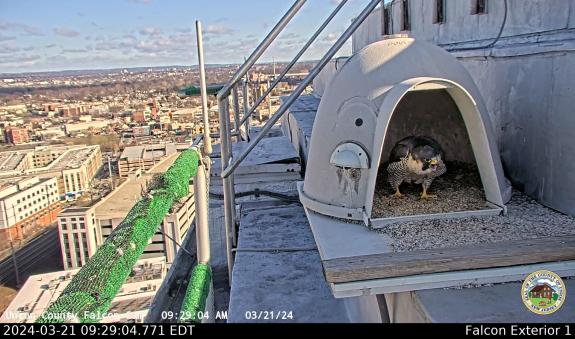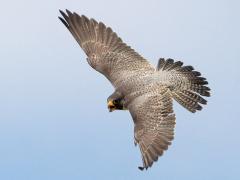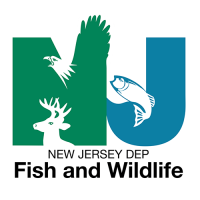Union County Falcon Cam
Conserve Wildlife Foundation of NJ has partnered with Union County to stream this falcon nest live from the roof of the County Courthouse in downtown Elizabeth, New Jersey.
March 2024 - The third view is available on our YouTube channel and Union County's website. We will add it to this page this summer after the nestlings get to around 4 weeks old.
Buildings and their owners/managers have played an important role in the successful recovery of Peregrine falcons in New Jersey. After a pair attempted to nest (and were unsuccessful) here in 2005, building managers took action to give these birds a second chance. Since windy conditions made nesting on the roof impossible, Union County staff, as directed by state wildlife zoologist Kathy Clark, installed a Dogloo, also referred to as a "Peregloo" to provide a more suitable nest site. After installing the Peregloo, the nesting pair was productive! Since then the site has been occupied by falcons. In 2016, there was a turnover at the nest and the female was replaced with a young adult. Then in 2019, the current female (who is unbanded), named "Frida" replaced the previous female.
>> Check out our interaction page to post snapshots, ask questions and interact with other viewers!
NestBox News:
April 30

A lot has occurred since our last update! We now have a brood of four young. They hatched (4/24 - 1 & 2, 4/25 - 3, 4/26 - 4). Over the past week Frida has been doing an excellent job of caring for them. With the warm weather yesterday and today, she hasn't had to brood them much besides in the evening. Now that they're almost a week old, their fluffy down feathers help to keep them warm. Also, snuggling together in a ball helps as well. :)
On Friday morning, we will be visiting the site to medicate the young for trichomoniasis with Cathy Malok with The Raptor Trust. This is a pigeon borne disease which can kill young falcons if they become infected with the parasite. This is done as a precautionary meaasure to help ensure that the young remain healthy since a lot of their diet consists of pigeons.
April 12
Not much has been going on besides incubation exchanges between the male and female and an earthquake that was observed here on April 5 at 10:23am.
We're now pass the halfway point of incubation and the young falcon is developing quickly within the egg. Eggs are kept warm at about the same temperature as the human body or 98.6 degrees F. In another 10-14 days hatch watch will begin.
March 28
The pair here now have a full clutch of four eggs! In the video above, you will see Frida lay the forth. This is such an amazing thing to witness, which woudn't be possible with this camera. With a full clutch, the pair will now take turns incubating the eggs for the next thirty days. During this time they will roll and turn the eggs so they develop properly.
When you watch you may see the falcon with one eye open and one closed, this is when they're sleeping. This is where half their brain sleeps and the other is active, so they can rest while also still being alert to potential predators. This is called unihemispheric slow-wave sleep (USWS) and some birds can even do this while in flight during migration! BW
March 21
 Frida leaves her nest to defend against a possible intruder.
Frida leaves her nest to defend against a possible intruder.
For those who have tuned in lately, we have been witnessing what is likely a territorial dispute, which is when a rival adult is attempting to takeover the nest. We have seen this when the female calls and leaves her nest to defend her territory. This happened yesterday and again this morning. The male has also been heard calling alongside his mate. We are not sure if it is a male or female who is attempting the takeover, but 2019 the previous female was replaced by this unbanded female (Frida). We are seeing this occur more and more at established nests as they are desirable to breeding age adults, which there are more of these days than in past years.
It is hard to capture on camera but we may see a glimpse of a passing falcon on the wing. Behavior of adults is how we can tell what is going on and having audio really helps when they are not visible on camera. Time will tell if any turnover will occur here. BW
March 20, 2024
Well, spring is here and for raptor biologists, that means it's egg laying season! Here at the Union County Courthouse, they have two eggs. The first was laid on Saturday, March 16 and the second on March 19. The third should be laid in the next day or two. Frida is a bit early this year, but not far off from previous years. Last year the first egg was laid on March 19 and in 2022 the first was laid on March 18. Here is a video clip showing both eggs.
She will continue to sit on the eggs but also takes breaks where the eggs will be left alone. If she is not on camera, then she is nearby. These falcons defend their territories very aggressively, especially during this time of year. Incubation will begin when they have a full clutch of 3-4 eggs. They are incubated for around 30 days, so hatching should occur during Earth Week. BW
Falcon Cam Education
 Zoom+ A female peregrine falcon. Photo courtesy of Kim Steininger.
Zoom+ A female peregrine falcon. Photo courtesy of Kim Steininger.
CWF’s Soaring with STEM program educates children about New Jersey’s unique natural resources and the rare wildlife that shares our environment using the Union County Falcon Cam as the primary technological learning tool. Through interactive and engaging classroom and assembly presentations, our experienced educators bring wildlife into your school. Students are fascinated to discover that these raptors nest and raise young each year right in their own backyards! Teachers receive structured lessons and interactive activities to address the Next Generation Science Standards for grades 3-5. Learning about their wildlife neighbors helps children to connect to their community and teaches children to consider how their everyday actions impact the natural world around them. A special thanks to Phillips 66 for their sponsorship of the Union County Educational programs utilizing the Union County Falcon Cam.
Contact Us:
Liz Silvernail, Executive Director: Email
Ben Wurst, Senior Wildlife Biologist: Email
Find Related Info: Peregrine Falcon, Raptors, Endangered







